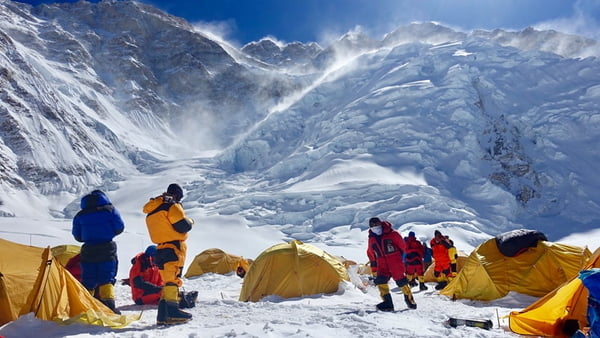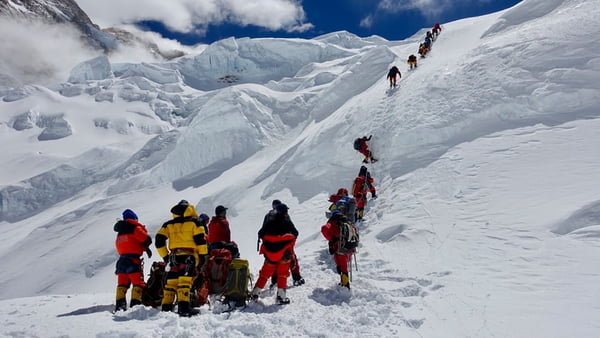
Daily Mountain
48 years, Australia
Crowds and Solitude on Kangchenjunga
Earlier this spring, 58 people reportedly summited Kangchenjunga. (Some say the tally is actually 68.) While not a record, this is still a world away from the peak’s lonely history. Tagged as difficult, isolated and “only” the third tallest mountain on Earth, Kangchenjunga is not even a favorite among the 8000’ers.
 Snow smoke on Kangchenjunga. Photo: Juan Pablo Sarjanovich
Snow smoke on Kangchenjunga. Photo: Juan Pablo Sarjanovich
Yet this year, two big operators (Seven Summit Treks and Peak Promotion) operated out of its Base Camp, supplying the higher camps and fixing ropes from bottom to top. On May 16, climbers converged en masse on the upper sections and at the summit. Only one of those used no supplementary O2: Chilean Rodrigo Vivanco. Three people died that day from exhaustion –- and the no-O2 climber was among them.
This season too, media and armchair experts have united loudly against the mountain tourist, mainly on Everest, but Kangchenjunga’s sudden popularity puts it in the same crosshairs.
For a perspective on what it was really like on Kangchenjunga from someone who was there, we spoke to Juan Pablo Sarjanovich. His outspoken, honest account adds shades of grey to the blacks and whites of social media.
The 43-year-old from Rosario, Argentina is neither a full-time professional climber nor a “tourist”. He has roamed the Andes since he was a child and has climbed across South America and Europe before jumping to the Himalaya. Here, he first attempted a virgin 6000’er, Sharpu 4. He then decided to climb all the 8000’ers not yet summited by an Argentinean.
He started with Manaslu, and succeeded on his second attempt. “I reached the top of Manaslu one hour after two friends of mine, who were also from Argentina, so the goal sort of escaped me,” he admitted ruefully.
Last year, he attempted Broad Peak. Also on his to-do list are Nanga Parbat and Annapurna. But his first real success came on Kangchenjunga.
 Juan Pablo Sarjanovich in Base Camp
Juan Pablo Sarjanovich in Base Camp
“I am no expert, that was only my fifth Himalayan expedition,” Sarjanovich told ExplorersWeb modestly. “I shared Base Camp with Abele Blanc, a no-O2 14 x 8000 summiter. That is expertise!
“We were 12 western climbers, and five of them were on their second or third attempt on Kangchenjunga, so no one was really a beginner,” he added.
Others sharing the mountain with them included local guides and huge teams of Indian climbers. Kangchenjunga happens to be the tallest in India, with its booming economy and 1.3 billion inhabitants. The Indian government grants no permits for the Sikkim side, so all expeditions do the normal route out of Nepal. It was among the Indian teams that inexperienced climbers abounded.
“Many had no experience walking on crampons, using Jumars or rappelling down. They were absolutely dependent on fixed ropes.”
 Climbers wait in line on the way to Camp 3. Photo: Juan Pablo Sarjanovich
Climbers wait in line on the way to Camp 3. Photo: Juan Pablo Sarjanovich
Sarjanovich paid for a fully-supplied expedition with Seven Summit Treks and shared BC with four other people, but climbed his own way most of the time:
“I didn’t use HA Sherpas or fixed ropes until the final push. I acclimatized at my own pace, pitching my own higher camps. I did touch fixed ropes on four or five vertical ice sections. During the summit push, since I had all services included, I went up with a Sherpa, not roped together but simply accompanying me, so I didn’t have to climb alone. It was a question of safety … and I felt better that way. I started using supplementary O2 above Camp 4, at 7,600m. I had taken three canisters with me. I set off from Camp 4 without O2, together with Rodrigo Vivanco. Two hours later, I felt it was taking too long, so I decided to switch on the gas.”
Here is Sarjanovich’s account of the extremely long summit day:
“Everyone I talked to confirmed that Kangchenjunga is the most difficult of the 8000’ers on the normal route. In my case, this is by far the hardest climb I’ve ever done. On the summit day, I left C3 (7,000m) at 9 a.m. and reached C4 five hours later. There, I rested for three hours, and at about 5:30 p.m., I was ready to go for the top.
 Sarjanovich in a high camp
Sarjanovich in a high camp
“The first section above Camp 4 is a 45º hard snow ramp until the col between Kangchenjunga and Kangbachen at 8,200m. From that point, you enter a couloir of mixed terrain that leads to the summit. It includes some rather technical sections. There are no alternatives: This is the only way up.
“Inexperienced climbers slowed us down. This is where you can really tell the clients from the climbers. Some were tripping and slipping on the rocky parts all the time, maneuvering slowly, totally dependent on their Jumars, and their progress gets even worse going down.
“There was a traffic jam about one hour from the top. I waited for one hour, maybe two. It was ugly. In all, there were over 1,600 vertical metres of ascent and 28 hours on the go — 24 hours from C3 to the summit and 4-5 hours back to C4. It was exhausting.”
Sarjanovich denies that the number of summits was higher than previous years. “This season, there was only one summit day, but it was perfect, with beautiful, windless weather,” he said. “Everyone went at the same time, which increased the traffic jams.”
About the potentially dangerous situations created by so many inexperienced climbers, “honestly, I do not have a clear opinion,” Sarjanovich said. “And there’s been too much talking already, particularly from people who haven’t been much further than their computer screens. Nevertheless, I do draw a distinction between mountaineering and being a mountain client.”
Crevasses foil Nives Meroi and Romano Benet on Kangbachen
If the crowds hauling themselves toward the summit of Kangchenjunga had looked down the col towards Kangbachen, they might had seen a lonely pair of highly seasoned climbers: Italian 14 x 8000’ers Romano Benet and Nives Meroi. Their unseen Base Camp lay just below the plain where the Kangchenjunga climbers gathered.
“We tried to climb the south face of Kangbachen,” Meroi told ExplorersWeb, “but we didn’t manage because of big series of crevasses. We’d have needed ladders, as in the Khumbu Ice Fall, to overcome such an obstacle.”
“We hardly managed to climb half of the wall,” Meroi added. “Maybe it has been a low snow year, because all crevasses were open and we didn’t find the way across.”
To show what they faced, the climbers sent the following pictures of a truly untamed mountain:


This article first appeared on http://explorersweb.com. The original can be read here.





